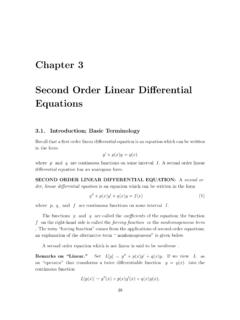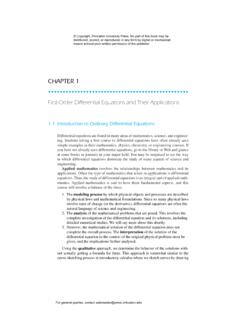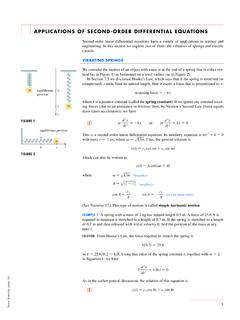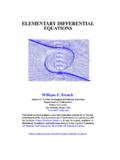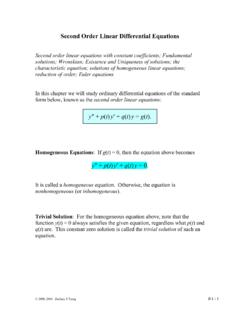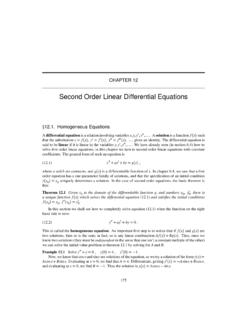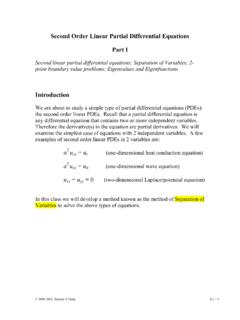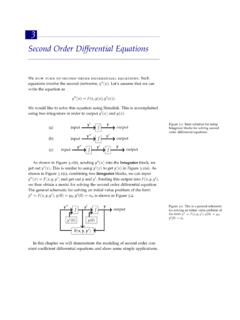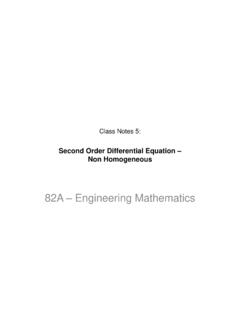Transcription of Second Order Linear Differential Equations
1 CHAPTER 3 Second Order Linear Differential Introduction; Basic Terminology and ResultsAny Second Order differential equation can be written asF(x,y,y ,y )=0 This chapter is concerned with special yet very important Second Order Equations , namelylinear that a first Order Linear differential equation is an equation which can be writtenin the formy +p(x)y=q(x)wherepandqare continuous functions on some intervalI. A Second Order , lineardifferential equation has an analogous Order Linear differential equationis an equation which canbe written in the formy +p(x)y +q(x)y=f(x)(1)wherep, q, andfare continuous functions on some functionspandqare called thecoefficientsof the equation; the functionfonthe right-hand side is called theforcing functionor thenonhomogeneous term.
2 The term forcing function comes from applications of Second - Order Linear Equations ; the description nonhomogeneous is given Second Order equation which is not Linear is said to (a)y 5y +6y= 3cos2x. Herep(x)= 5,q(x)=6,f(x)= 3cos2xarecontinuous functions on ( , ).(b)x2y 2xy +2y= 0. This equation is Linear because it can be written in the form(1) asy 2xy +2x2y=0wherep(x)=2/x, q(x)=2/x2,f(x) = 0 are continuous on any interval that doesnot containx= 0. For example, we could takeI=(0, ).63(c)y +xy2y y3=exyis a nonlinear equation; this equation cannot be written in theform (1). Remarks on Linear . Intuitively, a Second Order differential equation is Linear ify appears in the equation with exponent 1 only, and if either or both ofyandy appearin the equation, then they do so with exponent 1 only.
3 Also, there are no so-called cross-product terms,yy ,yy ,y y . In this sense, it is easy to see that the Equations in (a) and(b) are Linear , and the equation in (c) is [y]=y +p(x)y +q(x)y. If we viewLas an operator that transforms a twicedifferentiable functiony=y(x) into the continuous functionL[y(x)] =y (x)+p(x)y (x)+q(x)y(x),then, for any two twice differentiable functionsy1(x) andy2(x),L[y1(x)+y2(x)] = [y1(x)+y2(x)] +p(x)[y1(x)+y2(x)] +q(x)[y1(x)+y2(x)]=y 1(x)+y 2(x)+p(x)[y 1(x)+y 2(x)] +q(x)[y1(x)+y2(x)]=y 1(x)+p(x)y 1(x)+q(x)y1(x)+y 2(x)+p(x)y 2(x)+q(x)+y2(x)=L[y1(x)] +L[y2(x)]and, for any constantc,L[cy(x)] = [cy(x)] +p(x)[cy(x)] +q(x)[cy(x)]=cy (x)+p(x)[cy (x)] +cq(x)y(x)=c[y (x)+p(x)y (x)+q(x)y(x)]=cL[y(x)].
4 Therefore, as introduced in Section ,Lis alinear differential is the realreason that equation (1) is said to be alineardifferential equation. The first thing we need to know is that an initial-value problem has a solution, and thatit is 1. (Existence and Uniqueness Theorem)Given the Second Order linearequation (1). Letabe any point on the intervalI, and let and be any two realnumbers. Then the initial-value problemy +p(x)y +q(x)y=f(x),y(a)= , y (a)= has a unique before, a proof of this theorem is beyond the scope of this :We can solve any first Order Linear differential equation; Section 2-1 gives amethod for finding the general solution ofanyfirst Order Linear equation.
5 In contrast,thereis no general method for solving Second (or higher) Order Linear differential Equations . Thereare, however, methods for solving certain special types of Second Order Linear Equations andwe shall study these in this chapter. Extensions of these methods to higher Order linearequations will be given later. DEFINITION Linear differential equation (1) ishomogeneous1if the functionfon the right side of the equation is 0 for allx I. In this case, equation (1) becomesy +p(x)y +q(x)y=0.(2)Equation (1) isnonhomogeneousiffis not the zero function onI, , (1) is nonhomo-geneous iff(x)6= 0 for somex you will see in the work which follows, almost all of our attention will be focused onhomogeneous use of the term homogeneous is completely different from its use to categorize the first orderequationy =f(x,y) in Exercises Second Order Linear Homogeneous EquationsAs defined in the previous section, a Second Order Linear homogeneous differential equationis an equation that can be written in the formy +p(x)y +q(x)y= 0(H)wherepandqare continuous functions on some trivial solutionThe first thing to note is that the zero function,y(x)
6 = 0 for allx I, (also denoted byy 0) is a solution of (H) (y 0 impliesy 0 andy 0).The zero solution is called thetrivial solution. Obviously our main interest is in findingnontrivialsolutions. Unless specified otherwise, the term solution will mean nontrivialsolution. First we establish some essential facts about homogeneous (x) is a solution of (H) and ifCis any real number, thenu(x)=Cy(x) is also a solution of (H).ProofLety=y(x) be a solution of (H). Theny (x)+p(x)y (x)+q(x)y(x)= any real number, and setu(x)=Cy(x). Thenu(x)=Cy(x)u (x)=Cy (x)u (x)=Cy (x)Substitutinguinto (H), we getu (x)+p(x)u (x)+q(x)u(x)=Cy (x)+p(x)[Cy (x)] +q(x)[Cy(x)]=C[y (x)+p(x)y (x)+q(x)y(x)]=C[0]= ProofConsider the Linear differential operatorL[y]=y +p(x)y +q(x) (x) is a solution of (H),L[y(x)] = 0.
7 SinceLis a Linear operator,L[Cy(x)] =CL[y(x)] =C(0) = ,u(x)=Cy(x) is a solution of (H). In words, Theorem 1 says thatany constant multiple of a solution of (H) is also asolution of (H).66 THEOREM (x) andy=y2(x) are any two solutions of (H), thenu(x)=y1(x)+y2(x) is also a solution of (H).ProofLety=y1(x) andy=y2(x) be any two solutions of (H). Theny 1(x)+p(x)y 1(x)+q(x)y1(x) = 0 andy 2(x)+p(x)y 2(x)+q(x)y2(x)= setu(x)=y1(x)+y2(x). Thenu(x)=y1(x)+y2(x)u (x)=y 1(x)+y 2(x)u (x)=y 1(x)+y 2(x)Substitutinguinto (H), we getu (x)+p(x)u (x)+q(x)u(x)=y 1(x)+y 2(x)+p(x)[y 1(x)+y 2(x)] +q(x)[y1(x)+y2(x)]=[y 1(x)+p(x)y 1(x)+q(x)y1(x)] + [y 2(x)+p(x)y 2(x)+q(x)y2(x)]= 0+0= ProofSetL[y]=y +p(x)y +q(x)y;Lis a Linear operator.
8 Sincey=y1(x)andy=y2(x) are solutions of (H),L[y1(x)] =L[y2(x)] = 0. SinceLis Linear ,L[y1(x)+y2(x)] =L[y1(x)] +L[y2(x)]=0+0= ,u(x)=y1(x)+y2(x) is a solution of (H). Theorem 2 says thatthe sum of any two solutions of (H) is also a solution of (H).(Someauthors call this property thesuperposition principle.)Combining Theorems 1 and 2, we getTHEOREM (x) andy=y2(x) are any two solutions of (H), and ifC1andC2are any two real numbers, theny(x)=C1y1(x)+C2y2(x)is also a solution of (H).DEFINITION 1.( Linear Combinations) Letf=f(x) andg=g(x) be functionsdefined on some intervalI, and letC1andC2be real numbers. The expressionC1f(x)+C2g(x)is called alinear 3 says thatany Linear combination of solutions of (H) is also a solution of(H).
9 Note that the equationy(x)=C1y1(x)+C2y2(x)(1)whereC1an dC2are arbitrary constants, has the form of a general solution of equation(H). So the question is: Ify1andy2are solutions of (H), is the expression (1) the generalsolution of (H)? That is, can every solution of (H) be written as a Linear combination ofy1andy2? It turns out that (1) may or not be the general solution; it depends on therelation between the you can verify,y1(x)=exandy2(x)=e2xare each solutions ofy 3y +2y=0.(a)We want to determine whether or not the two-parameter familyy=C1ex+C2e2x(b)is the general solution of (a).Letu=u(x)beanysolution of (a) and let =u(0), =u (0). We will try to findvalues forC1andC2such thaty(x)=C1ex+C2e2xsatisfiesy(0) = andy (0) =.
10 We havey(x)=C1ex+C2e2x,y (x)=C1ex+2C2e2xSettingx= 0, we obtain the pair of equationsy(0) =C1+C2= y (0) =C1+2C2= .This pair of Equations has the unique solutionC1=2 , C2= . Now,y=(2 )ex+( )e2xandu(x)are each solutions of (a), andy(0) =u(0) = , y (0) =u (0) = . By the Existence andUniqueness Theorem,u(x) y(x). Thusu(x)=(2 )ex+( )e2xis a member of the two-parameter family (b). Sinceuwasanysolution of (a), we canconclude that (b) is the general solution of (a); (b) representsallsolutions of (a). Example functionsy1(x)=x2andy2(x)=5x2are solutions ofy 2xy +2x2y=0.(a)68We want to determine whether or not the two-parameter familyy=C1x2+C2(5x2)(b)is the general solution of (a).
